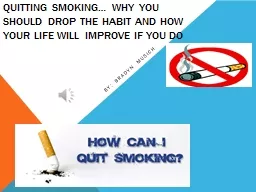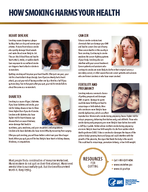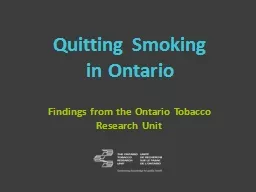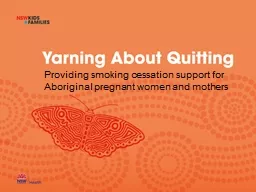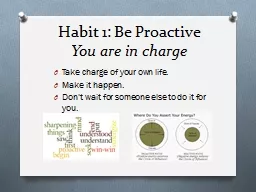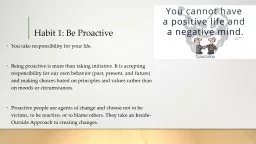PPT-Quitting smoking… Why you should drop the habit and how y
Author : aaron | Published Date : 2017-06-04
By Bradyn Musich Smoking is addictive but a habit worth dropping In 2011 190 of all adults 216 of males and 165 of females 438 million people smoke cigarettes
Presentation Embed Code
Download Presentation
Download Presentation The PPT/PDF document "Quitting smoking… Why you should drop ..." is the property of its rightful owner. Permission is granted to download and print the materials on this website for personal, non-commercial use only, and to display it on your personal computer provided you do not modify the materials and that you retain all copyright notices contained in the materials. By downloading content from our website, you accept the terms of this agreement.
Quitting smoking… Why you should drop the habit and how y: Transcript
By Bradyn Musich Smoking is addictive but a habit worth dropping In 2011 190 of all adults 216 of males and 165 of females 438 million people smoke cigarettes Each day nearly 4000 persons younger than 18 years of age smoke their first cigarette. es What time is it What craving do you think your habit is satisfying Where are you What did you just do TE T THAT THEO Y Who else is around What emotion are you feeling THE EWA RD THE OUTINE Keep experimenting until you 64257nd something new that s Recent studies show that smokers who talk to a clinician about how to quit dramatically increase their chances of quitting successfully Quitting smoking is the most important step you can take to improve your health Your doctor can help you quit TIP in Ontario. Findings from the Ontario Tobacco Research Unit. Trying to Quit. Factors that affect quitting. Top Quit Aids. Getting Help. Chances Improve. Findings from the Ontario Tobacco Survey and other OTRU studies. To see this poster online and for more details, including references, go to: . TOBACCO JEOPARDY!!. Created by Celia . Culley. . BSP . and Rob . Pammett. . BSP. Updated June 2010. Main board. Cigarettes. Smokeless Tobacco. Negative Health Effects. Benefits of Quitting. Obstacles to Quitting. Supporting customers to quit. What you need to know. PSA Presentation text. 2. Discuss the health risks associated with smoking, and the benefits of quitting. Apply the 5A principles of smoking cessation to support customers to quit . Acknowledgement of Country. We acknowledge the Aboriginal custodians of the land we meet on today.. We pay our respects to the Elders past and present, and extend that respect to Aboriginal people present today.. Are you ready to quit?. In today’s presentation . PSA Presentation text. 2. The health risks associated with smoking. The health benefits of quitting. How pharmacy can support you to quit. Nicotine replacement . Made by Khylam, Jenna and Angela. Negatives. Smoking causes several types of cancer such as . throat cancer. , . lung cancer. , and . tongue cancer. .. Smoking also causes . heart disease. .. Smoking can lead to . Eve S. What is habit?. Habit is a persons ordinary, regular, and nearly automatic response to a repeated situation.. Habit is closely related to character. Character is a generalized description of one’s disposition, or of one’s disposition in respect to a general trait such as honesty or peacefulness, while habit is more specific in describing ones regular response to a repeated situation.. Year Off Right!. Every January 1, people all over the world make New Year's resolutions. If you're one of the nearly 7 in 10 U.S. smokers who want to quit, why not make a resolution to get started? Smoking is still the number one cause of preventable death and disease in the United States. Quitting now can cut your risk for diseases caused by smoking and leave you feeling stronger and healthier.. Habit 1: Be Proactive You are in charge Take charge of your own life. Make it happen. Don't wait for someone else to do it for you. Habit 2: Begin With The End In Mind Habit 3: Put First Things First Habit 1: Be Proactive You take responsibility for your life . Being proactive is more than taking initiative. It is accepting responsibility for our own behavior (past, present, and future) and making choices based on principles and values rather than on moods or circumstances. 7 habits of highly effective teens. or. The 7 characteristics that happy and successful teens all over the world have in common. Habit #1. Be Proactive. Take responsibility for your life. Habit #2. 20 September 2022 . 1. PRESENTATION OVERVIEW. This presentation draws from a wider research project commissioned by ASH in early 2022, to gain insight to the nation’s smokers and their lives through qualitative exploratory work..
Download Document
Here is the link to download the presentation.
"Quitting smoking… Why you should drop the habit and how y"The content belongs to its owner. You may download and print it for personal use, without modification, and keep all copyright notices. By downloading, you agree to these terms.
Related Documents

